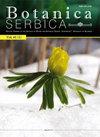巴尔干半岛超蓄积植物的发现:积累、分布和实际应用
IF 1.1
4区 生物学
Q4 PLANT SCIENCES
引用次数: 3
摘要
超积累植物能够忍受其生长的土壤中极高浓度的金属/类金属,并在其芽中积累高浓度。迄今为止,在欧洲植物区系多样性和物种形成的中心巴尔干地区共鉴定了31种超积累植物物种,在超镁铁质地区尤其丰富。另有8个物种尚未通过进一步的研究得到证实。31个高富集分类群(13个分类群,占41.9%)中大部分为Odontarrhena属,均超富集Ni元素,但在Bornmuellera和Noccaea(均为芸苔科)、Orobanche (Orobanchaceae)、Centaurea (Asteraceae)和Viola(堇菜科)中也发现了高于超富集阈值的Ni元素。Tl和Zn超积累体的存在是特别令人感兴趣的,因为世界上很少有物种能超积累这些元素。在科瓦氏菌中发现多种金属超富集,除主要富集元素镍外,还发现锌的超富集。本文讨论了金属超富集的系统发育关系和物种分布,特别关注了它们的系统学、新超富集物种的发现和识别以及它们在植物技术中的实际应用的可能性。本文章由计算机程序翻译,如有差异,请以英文原文为准。
Hyperaccumulator plant discoveries in the Balkans: Accumulation, distribution, and practical applications
Hyperaccumulator plants are able to tolerate extremely high concentrations of metals/metalloids in the soil in which they grow and to accumulate high concentrations in their shoots. To date, a total of 31 hyperaccumulator plant species have been identified in the Balkans, the centre of diversity and speciation in the European flora which is particularly rich in ultramafic areas. A further 8 species have yet to be confirmed through additional studies. Most of the 31 hyperaccumulator taxa (13 taxa or 41.9%) are species of the genus Odontarrhena, all hyperaccumulating Ni, but concentrations of this element above the hyperaccumulation threshold were also found in the genera Bornmuellera and Noccaea (all Brassicaceae), Orobanche (Orobanchaceae), Centaurea (Asteraceae) and Viola (Violaceae). The existence of hyperaccumulators of Tl and Zn is of particular interest because very few species worldwide hyperaccumulate these elements. Multiple metal hyperaccumulation was found in Noccaea kovatsii, as the hyperaccumulation of Zn was found in this species in addition to Ni, the primary accumulated element. Metal hyperaccumulation is discussed in terms of phylogenetic relationships and species distributions, with special attention to their systematics, the detection and recognition of new hyperaccumulating species and the possibilities for their future practical applications in phytotechnologies.
求助全文
通过发布文献求助,成功后即可免费获取论文全文。
去求助
来源期刊

Botanica Serbica
Agricultural and Biological Sciences-Plant Science
CiteScore
1.40
自引率
12.50%
发文量
17
审稿时长
34 weeks
期刊介绍:
Botanica Serbica publishes original research papers on all aspects of plant, fungal and microbial biology research including the disciplines of microbiology, mycology, lichenology, bryology, flora, vegetation, biogeography, systematics, taxonomy, plant biotechnology, plant cell biology, plant ecology, environmental plant biology, forestry, genomics, horticulture, limnology, metabolomics, molecular biology, proteomics, virology, plant conservation and protection, and wildlife and ecosystem management.
 求助内容:
求助内容: 应助结果提醒方式:
应助结果提醒方式:


